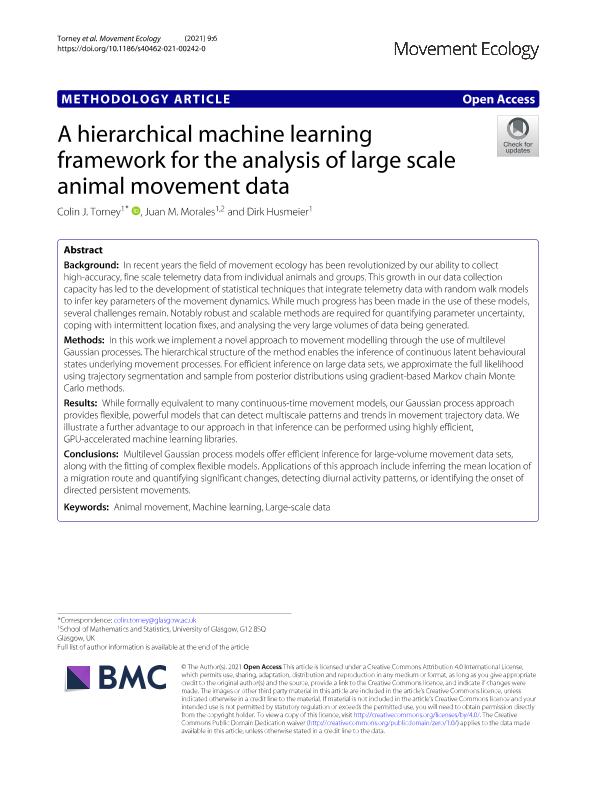Mostrar el registro sencillo del ítem
dc.contributor.author
Torney, Colin J.
dc.contributor.author
Morales, Juan Manuel

dc.contributor.author
Husmeier, Dirk
dc.date.available
2023-01-06T13:36:49Z
dc.date.issued
2021-12
dc.identifier.citation
Torney, Colin J.; Morales, Juan Manuel; Husmeier, Dirk; A hierarchical machine learning framework for the analysis of large scale animal movement data; BioMed Central; Movement Ecology; 9; 1; 12-2021; 1-11
dc.identifier.uri
http://hdl.handle.net/11336/183698
dc.description.abstract
Background: In recent years the field of movement ecology has been revolutionized by our ability to collect high-accuracy, fine scale telemetry data from individual animals and groups. This growth in our data collection capacity has led to the development of statistical techniques that integrate telemetry data with random walk models to infer key parameters of the movement dynamics. While much progress has been made in the use of these models, several challenges remain. Notably robust and scalable methods are required for quantifying parameter uncertainty, coping with intermittent location fixes, and analysing the very large volumes of data being generated. Methods: In this work we implement a novel approach to movement modelling through the use of multilevel Gaussian processes. The hierarchical structure of the method enables the inference of continuous latent behavioural states underlying movement processes. For efficient inference on large data sets, we approximate the full likelihood using trajectory segmentation and sample from posterior distributions using gradient-based Markov chain Monte Carlo methods. Results: While formally equivalent to many continuous-time movement models, our Gaussian process approach provides flexible, powerful models that can detect multiscale patterns and trends in movement trajectory data. We illustrate a further advantage to our approach in that inference can be performed using highly efficient, GPU-accelerated machine learning libraries. Conclusions: Multilevel Gaussian process models offer efficient inference for large-volume movement data sets, along with the fitting of complex flexible models. Applications of this approach include inferring the mean location of a migration route and quantifying significant changes, detecting diurnal activity patterns, or identifying the onset of directed persistent movements.
dc.format
application/pdf
dc.language.iso
eng
dc.publisher
BioMed Central

dc.rights
info:eu-repo/semantics/openAccess
dc.rights.uri
https://creativecommons.org/licenses/by/2.5/ar/
dc.subject
ANIMAL MOVEMENT
dc.subject
LARGE-SCALE DATA
dc.subject
MACHINE LEARNING
dc.subject.classification
Ecología

dc.subject.classification
Ciencias Biológicas

dc.subject.classification
CIENCIAS NATURALES Y EXACTAS

dc.title
A hierarchical machine learning framework for the analysis of large scale animal movement data
dc.type
info:eu-repo/semantics/article
dc.type
info:ar-repo/semantics/artículo
dc.type
info:eu-repo/semantics/publishedVersion
dc.date.updated
2022-10-06T13:16:31Z
dc.identifier.eissn
2051-3933
dc.journal.volume
9
dc.journal.number
1
dc.journal.pagination
1-11
dc.journal.pais
Reino Unido

dc.journal.ciudad
Londres
dc.description.fil
Fil: Torney, Colin J.. University of Glasgow; Reino Unido
dc.description.fil
Fil: Morales, Juan Manuel. University of Glasgow; Reino Unido. Consejo Nacional de Investigaciones Científicas y Técnicas. Centro Científico Tecnológico Conicet - Patagonia Norte. Instituto de Investigaciones en Biodiversidad y Medioambiente. Universidad Nacional del Comahue. Centro Regional Universidad Bariloche. Instituto de Investigaciones en Biodiversidad y Medioambiente; Argentina
dc.description.fil
Fil: Husmeier, Dirk. University of Glasgow; Reino Unido
dc.journal.title
Movement Ecology
dc.relation.alternativeid
info:eu-repo/semantics/altIdentifier/url/https://movementecologyjournal.biomedcentral.com/articles/10.1186/s40462-021-00242-0
dc.relation.alternativeid
info:eu-repo/semantics/altIdentifier/doi/http://dx.doi.org/10.1186/s40462-021-00242-0
Archivos asociados
